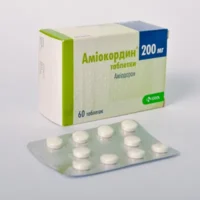Description
Enalapril-TEVA (enalapril) tablets 5 mg. №30
Composition
Active ingredient: Enalapril maleate 5 mg.
Mechanism of Action
Mechanism of Action: Enalapril works by inhibiting the angiotensin-converting enzyme (ACE), leading to vasodilation and reduced aldosterone secretion. This pharmacological effect results in lowered blood pressure and improved cardiac function.
Pharmacological Properties
Pharmacological Properties: Enalapril’s inhibition of ACE results in decreased angiotensin II levels, leading to vasodilation. Additionally, it reduces aldosterone secretion, which helps in lowering blood pressure and improving cardiac output.
Indications for Use
Indications: Enalapril-TEVA is indicated for the treatment of hypertension, heart failure, and to improve survival following a heart attack.
Contraindications
Contraindications: Avoid taking Enalapril-TEVA if you have a known allergy to enalapril or any other ACE inhibitor. Consult your healthcare provider for suitable alternatives.
Side Effects
Side Effects: Common side effects of Enalapril-TEVA may include dizziness, cough, or headache. Inform your doctor if any side effects persist or worsen.
Usage Instructions
Usage Instructions: Take Enalapril-TEVA precisely as directed by your physician. Swallow the tablet whole with a full glass of water. The typical initial dose is 2.5 mg once daily, with adjustments made by your doctor as necessary.
Benefits Compared to Analogues
Benefits: Enalapril has been shown to effectively lower blood pressure and enhance heart function in patients with heart failure. Compared to other medications, Enalapril-TEVA has demonstrated significant benefits in reducing cardiovascular events and mortality rates.
Suitable Patient Groups
Suitable Patient Groups: Enalapril-TEVA is suitable for adults, including the elderly population, for the management of hypertension, heart failure, and post-myocardial infarction care. Pediatric use should be under the guidance of a pediatric specialist.
Storage and Shelf Life
Storage: Store Enalapril-TEVA at room temperature, away from moisture and heat, to maintain its stability. Keep the product out of reach of children and pets.
Packaging Description
Packaging Description: Each pack of Enalapril-TEVA contains 30 tablets, each tablet containing 5 mg of enalapril maleate. The packaging is designed to ensure product integrity and patient safety.
Clinical Evidence and Proven Effectiveness
Clinical Evidence: Clinical studies have demonstrated the efficacy of enalapril in reducing cardiovascular events and mortality rates in patients with heart failure. A notable study published in the New England Journal of Medicine revealed a significant reduction in the risk of death and hospitalization among patients treated with enalapril compared to a placebo group.





